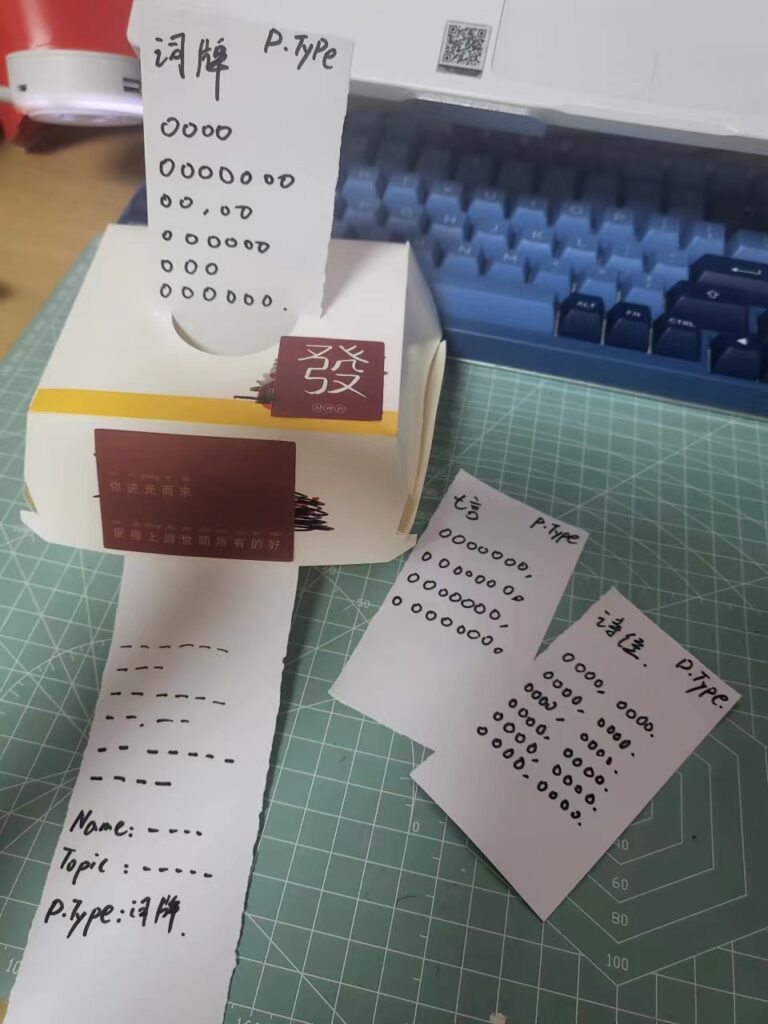Presentation and Project:
Link to the slides with pics and more links inside:
https://docs.google.com/presentation/d/1AP0EMOc_WBaUL26TeJAsf2UIhs_z2B3nj3EHAjcMFMs/edit?usp=share_link
Poet Suit is a physical suit that allows the user to become a poet and play with different styles of ancient Chinese poems. The poet suit is divided into four parts: intelligent glasses, Metrical Clothing (Left: Qiyan Tang uniform; Right: Zayan ancient clothing ), Rhythm Lenses, and Poet Instrumen. The question I want to discuss is how to avoid cultural loss while the evolution of language is unstoppable since language is the record of history, but the pronunciation of ancient Chinese has already been lost. This Poet Suit is the solution I bring out, turning writing a poem into entertainment.


The target audiences are Mandarin speakers and learners with basic knowledge of ancient Chinese poems. The primary experience I want to bring out is interacting with or experiencing the poem. I did not choose to let the audience simply read or listen to a poem because most Mandarin speakers have a terrible memory of reading and memorizing ancient Chinese poems to pass the exam. As a result, I decide to link the poem with the music to create a new experience. However, reading or listening to Chinese poetry can be the future core experience for non-Mandarin speakers.
Trail of Research
Topic choose
I’m pretty sure I want to discuss the policy of deleting the pronunciation of some characters in Mandarin. However, my intention is not clear at the very beginning. I know that I can’t entirely agree with this policy, but I didn’t think deeply enough about why I object to this policy. In the first half of the progress, I was trying to ask my audience to be against this policy together while personally, I hate influencing other people’s opinions. Then I realized I just wanted my audience to see or experience what is happening now and what questions we were facing. I want to let them decide whether this policy is reasonable and whether it would lead to some harmful effects. As a result, my intention changed to discuss the relationship between the development of the language and the heritage of the culture in a restrained way.
Daily Practice
During my one-week daily practice, I choose to try to play 水调歌头(Prelude to Water Melody) with ~6 different instruments. Prelude to Water Melody is an ancient Chinese poem. It has been set to music, and the song is popular in different generations of China.
By doing so, I realize that music can shorten the distance between people and poetry and make poetry less severe. This discovery led me to make the instrument in the suit.
System map
Link to system maps: https://miro.com/app/board/uXjVPI0fKpY=/?share_link_id=466501556636
Two maps are made to figure out the history and structure of the ancient Chinese poem. During the research, I also found a website for generating ancient Chinese poems with AI. This website inspired me that although it might be hard for normal people to create poetry, they can finish this task with the help of AI.
Janky Prototypes
Janky prototypes show three potential directions I have. The rhythmic beauty evaluator is trying to question what decides a poem’s ” beauty “: the content, the structure, or the sound. The poetry printer tries to arouse the discussion of whether AI can replace writers in literary creation. The poet suit is more about “who you are” and what makes you a poet. The poetry printer and the poet suit later become parts of my final project.
After finishing three prototypes, I realize I am pessimistic about these questions. However, I still want to make something more positive and convey a positive attitude. I ensured that I wanted to share that people and technology complement each other, not that artificial intelligence/rules limit humans.
User Journey Map and User Testing
The user journey map is the “predecessor” of the instruction book. In the beginning, the map is only for me to reverse my project, but during the user testing, I found some problems.
I invite my parents (55 years old), my friend (25 years old), and my former colleague(34 years old) to the test. The general process of the test is as follows. First, I introduce the project’s background; second, I show them the suit. The next step was a bit different; I played a 1min30s instruction video to my friend but explained how the project worked and what they needed to do to my parents and my former colleague. Then I let them interact with the project and ask questions.
User testing is not going well. They all start to ask questions like “what should I do now?”, “then?“, “am I right?” and so on. My friends have the fewest questions, but he also says that the video did not help much. As a result, I added an instructions book for the project and asked the audience to finish it before interacting with it.
Also, I realize the importance of figuring out the age range of my target audience, and the project might need some simplification in the future.
Bibliography










